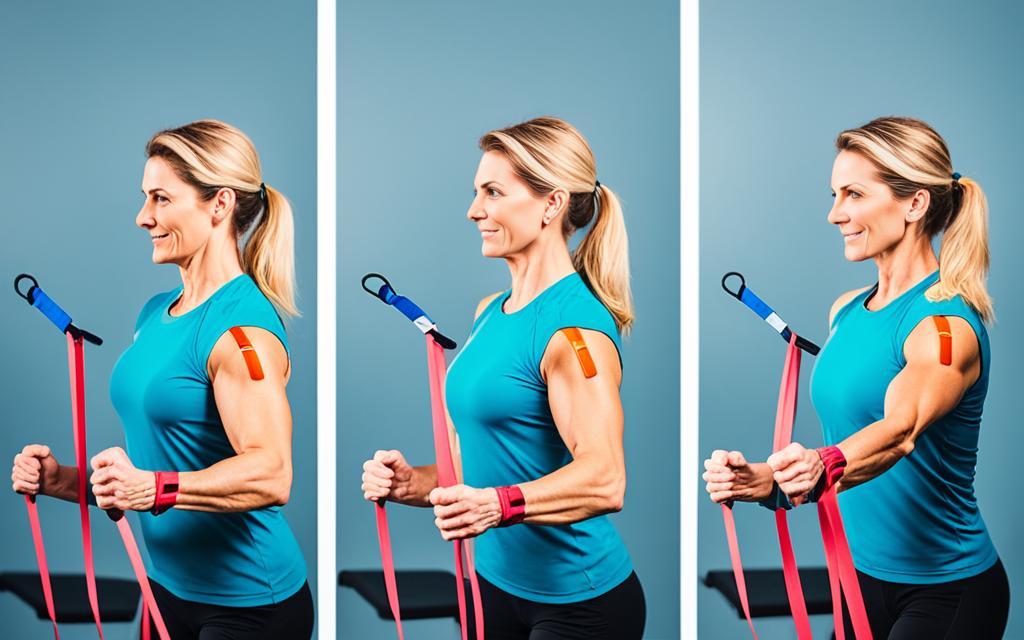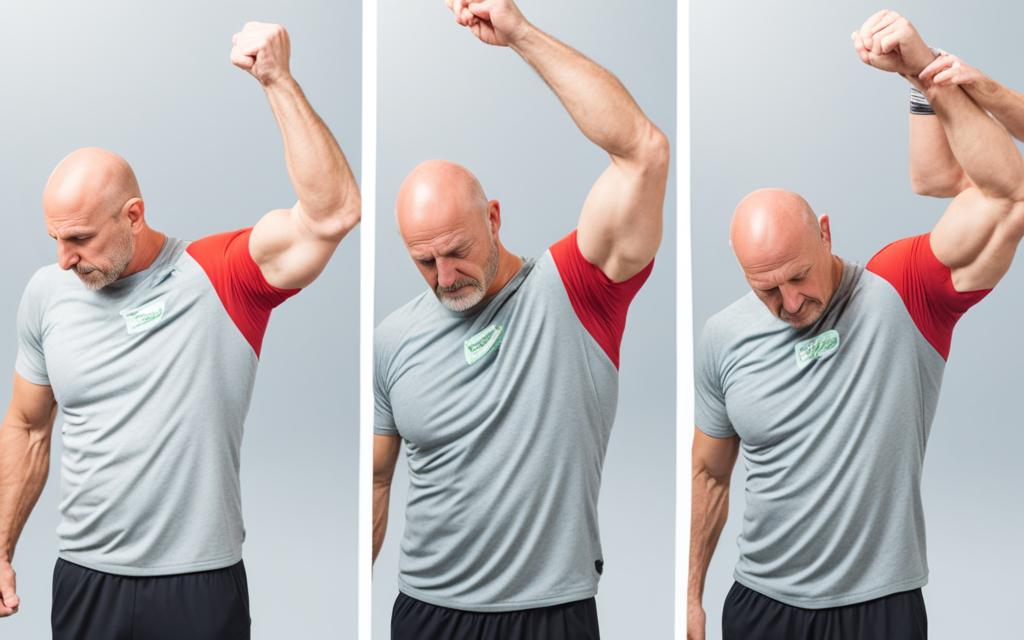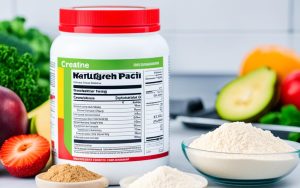Welcome to our comprehensive guide on resuming Exercise after a shoulder cortisone injection. We understand how important it is for you to get back to your fitness routine while ensuring a safe and successful recovery. In this article, we will provide you with a detailed timeline and exercises to help you navigate the post-injection phase with confidence.
Key Takeaways:
- Slowly reintroduce exercise after a shoulder cortisone injection to avoid jeopardizing your recovery.
- Consult with your healthcare provider before starting or modifying any exercise routine.
- Understand the different phases of recovery and the recommended exercises for each stage.
- Focus on strengthening exercises to rebuild the muscles surrounding the shoulder joint.
- Gradually increase exercise intensity and range of motion as you progress in your recovery journey.
Understanding Cortisone Injections for Shoulder
Before delving into the exercise timeline for shoulder cortisone injection recovery, it’s essential to understand the purpose and mechanics behind cortisone injections. These injections are commonly used to provide pain relief and reduce inflammation in the shoulder.
Cortisone injections contain a powerful anti-inflammatory medication, corticosteroid, which is injected directly into the affected area of the shoulder. This medication helps to suppress the immune response and decrease inflammation, ultimately alleviating pain and promoting healing.
While cortisone injections can provide significant relief for shoulder pain, it’s important to note that they are not a cure-all solution. They should be used in conjunction with other treatments, such as physical therapy and rest, to address the underlying issue causing the pain.
The recovery process following a cortisone injection varies from person to person. In some cases, individuals may experience immediate pain relief, while others may require more time for the medication to take effect. It’s crucial to have realistic expectations and give your body the necessary time to heal.
“Cortisone injections can be a valuable tool in managing shoulder pain, but they should always be used in combination with appropriate rest and rehabilitation exercises.” – Dr. Emily Johnson, Orthopedic Specialist
Immediate Post-Cortisone Injection Phase
After receiving a cortisone injection in your shoulder, it’s important to allow your shoulder time to rest and recover. During the immediate post-injection phase, it is recommended to engage in specific activities and gentle exercises that promote healing and prevent further injury.
Recommended Activities
During the immediate post-injection phase, you should prioritize activities that do not place excessive strain on your shoulder. Here are some recommendations:
- Rest: Allow your shoulder to rest for the first 24-48 hours after the injection.
- Ice: Apply ice packs to the injected area to reduce inflammation.
- Gentle movements: Perform simple range of motion exercises, such as shoulder rolls and pendulum swings, to prevent stiffness.
By following these recommendations, you can provide your shoulder with the necessary care and promote a smooth recovery in the days immediately after the cortisone injection.
Exercises to Avoid
While it’s important to keep your shoulder mobile during this phase, it’s equally vital to avoid exercises that may hinder the recovery process. Here are some exercises to avoid:
- Heavy lifting or weight training that directly targets the shoulder.
- Intense cardiovascular exercises that place excessive strain on the shoulder joint.
- Activities that involve repetitive overhead movements, such as throwing or serving a ball.
“The immediate post-injection phase is crucial for allowing the cortisone to work its magic while supporting your shoulder’s healing process. Be mindful of the exercises you choose to ensure you don’t impede your recovery progress.”
In summary, the immediate post-cortisone injection phase requires a balance of gentle movements, proper rest, and avoiding exercises that may aggravate the shoulder. By following these recommendations, you can set the stage for a successful recovery and pave the way for gradually reintroducing more challenging exercises in the weeks to come.
| Recommended Activities | Exercises to Avoid |
|---|---|
| Rest | Heavy lifting or weight training that directly targets the shoulder |
| Ice | Intense cardiovascular exercises that place excessive strain on the shoulder joint |
| Gentle movements | Activities that involve repetitive overhead movements, such as throwing or serving a ball |
First Week Post-Injection
After the initial recovery period, it’s natural to feel eager to get back to your workout routine. However, it’s important to approach exercise with caution during the first week after a shoulder cortisone injection. By taking the necessary precautions, you can promote a safe and effective recovery.
During this critical stage, it’s crucial to listen to your body and avoid any activities that may strain or irritate your shoulder. Here are some shoulder cortisone shot exercise precautions to keep in mind:
- Modify your workouts: Opt for low-impact exercises that minimize stress on your shoulder joint. Avoid lifting heavy weights or engaging in high-intensity activities.
- Focus on range of motion: Perform gentle stretching exercises to improve flexibility and maintain range of motion in your shoulder. Avoid pushing yourself too far and causing discomfort.
- Use proper form: Ensure that you maintain proper posture and technique while performing exercises to prevent any unnecessary strain on your shoulder.
- Gradually increase intensity: While it’s important to rest and take it easy during the first week post-injection, you can slowly increase the intensity of your exercises as your shoulder continues to heal.
Remember, every individual’s recovery process is unique. It’s crucial to consult with your healthcare provider or physical therapist to determine the most appropriate exercises for your specific situation.
By following these shoulder cortisone shot exercise precautions, you can support your shoulder’s healing process and gradually regain strength and function. Remember to prioritize your recovery and make adjustments to your exercise routine as needed.
Second Week Post-Injection
As you enter the second week after your shoulder cortisone injection, you may be starting to regain your confidence and feel ready to reintroduce exercise into your routine. However, it’s important to proceed with caution and prioritize your recovery.
During this stage, focus on gentle exercises that promote flexibility and mobility without putting excessive strain on your shoulder. These exercises will help to facilitate the healing process and gradually rebuild strength in the affected area.
Recommended Exercises
Below are some recommended exercises to incorporate into your second-week post-injection routine:
- Shoulder Rolls: Stand tall and roll your shoulders forward and backward in a controlled motion. This exercise helps to improve blood circulation, decrease stiffness, and increase flexibility.
- Passive Range of Motion: Gently move your affected shoulder through its full range of motion, but let the uninjured arm do most of the work. This exercise helps to maintain joint mobility and prevent muscle tightness.
- Wall Slides: Stand facing a wall with your back against it. Slowly slide your arms up the wall, stretching your shoulder in a controlled manner. This exercise helps to improve shoulder flexibility and build stability.
- Pendulum Exercises: Stand with your unaffected hand resting on a table or chair for support. Let your injured arm hang freely, and gently sway it forward, backward, and side to side. This exercise helps to loosen the shoulder joint and improve mobility.
Remember to always listen to your body and stop any exercise that causes pain or discomfort. It’s normal to experience some mild soreness, but sharp or intense pain could indicate an issue. Consult with your healthcare provider if you have any concerns.
To maintain safety and ensure a successful recovery, it’s important to follow the recommended intensity level for exercises during the second week. Start with low-impact exercises and gradually increase the load and intensity over time. Improper training can lead to further injury or setbacks, so it’s crucial to exercise with caution and patience.
In this second week post-injection, focus on rebuilding strength and flexibility gradually. Remember that everyone’s recovery process is unique, so it’s essential to consult with your healthcare provider for personalized guidance.
Listen to your body, and take the necessary precautions to exercise safely. Patience and moderation in your workout routine will set you up for a successful recovery.

| Exercise Type | Description |
|---|---|
| Shoulder Rolls | Stand tall and roll your shoulders forward and backward to improve blood circulation and flexibility. |
| Passive Range of Motion | Gently move your shoulder through its full range of motion, letting the uninjured arm do most of the work. |
| Wall Slides | Stand facing a wall and slide your arms up the wall to improve shoulder flexibility and stability. |
| Pendulum Exercises | Stand with your uninjured hand resting on a support and sway your injured arm gently to improve joint mobility. |
Third Week Post-Injection
By this point, your shoulder should be well on its way to recovery. It’s important to approach exercise with caution to avoid any setbacks. During the third week post-injection, you can gradually reintroduce specific exercises that promote shoulder strength, flexibility, and stability. However, it’s crucial to be mindful of any lingering discomfort or pain.
Don’t rush into high-intensity workouts or exercises that put excessive strain on your shoulder. Instead, focus on gentle movements that promote healing and support your recovery process. Remember, your body’s response to the injection may vary, so listen to your body and consult with your healthcare provider.
To help you navigate the third week post-injection, here are some exercises you can start incorporating into your routine:
| Exercise | Description |
|---|---|
| Shoulder Pendulum Swings | Stand with your unaffected arm supporting your body on a stable surface. Let your affected arm hang freely and gently swing it in a circular motion, clockwise and counterclockwise. Start with smaller circles and gradually increase the range of motion. |
| External Rotation with Resistance Band | Attach a resistance band to a secure anchor point at waist height. Stand with your affected arm holding the band and your elbow bent at 90 degrees. Slowly rotate your forearm outward, away from your body, against the resistance of the band. Repeat for several sets with controlled movements. |
| Modified Push-Ups | Lie face-down on a mat with your knees bent, feet flat on the ground, and hands placed slightly wider than shoulder-width apart. Keep your elbows close to your body as you push your upper body off the ground, using your unaffected arm primarily for support. Focus on engaging your core and maintaining proper form. |
| Low-Impact Cardiovascular Exercise | Engage in low-impact activities such as brisk walking, cycling, or swimming to promote cardiovascular health without putting excessive strain on your shoulder. Start with shorter durations and gradually increase the intensity and duration over time. |
Remember to perform each exercise with proper form and technique. Start with lighter weights or resistance and gradually increase as your shoulder tolerates the movements. If you experience any pain or discomfort during or after an exercise, it’s essential to modify or stop the activity and consult with your healthcare provider.
Fourth Week and Beyond
After diligently following your recovery plan for the past few weeks, you are now entering the fourth week post-shoulder cortisone shot. Congratulations on reaching this milestone! During this phase, you may feel ready to gradually increase the intensity of your workouts and regain full functionality in your shoulder.
It’s important to continue listening to your body and respecting its limits as you reintroduce more intense exercises. Pushing too hard too soon can potentially disrupt your recovery progress. Remember, patience and gradual progression are key to a successful rehabilitation.
Here are some tips to guide you as you navigate your workouts during the fourth week and beyond:
- Start with low-resistance exercises: Begin by incorporating low-resistance exercises to challenge your shoulder without overexerting it. This can include light weightlifting, resistance band exercises, or bodyweight movements.
- Add controlled movements: As your shoulder gains strength and stability, gradually incorporate controlled movements that mimic your daily activities and sports-specific motions. This will help improve functionality and enhance muscle coordination.
- Gradually increase intensity: Slowly increase the intensity of your workouts over time, focusing on proper form and technique. It’s important to strike a balance between challenging yourself and avoiding excessive strain on your shoulder.
- Combine strength and flexibility exercises: Continue performing both strengthening and stretching exercises to maintain balance and range of motion in your shoulder. A well-rounded exercise routine will promote overall shoulder health and minimize the risk of future injuries.
Remember, consult with your healthcare provider or physical therapist before progressing to more intense workouts. They can provide personalized guidance and ensure that you’re on the right track.
By following these recommendations and gradually building up your workouts, you’ll be well on your way to reclaiming your pre-injury level of activity.

| Benefits | Guidelines |
|---|---|
| Improved shoulder strength | – Progressively increase resistance and weight – Focus on proper form and technique |
| Enhanced functionality | – Incorporate controlled movements that mimic daily activities – Practice sports-specific motions |
| Optimized muscle coordination | – Perform exercises targeting multiple muscle groups – Ensure balanced strength and flexibility |
| Reduced risk of future injuries | – Continuously engage in strengthening and stretching exercises – Maintain overall shoulder health |
Strengthening Exercises
Strengthening exercises are essential for rehabilitating your shoulder and preventing future injuries. By targeting the muscles surrounding the shoulder joint, you can enhance stability and improve overall strength. Here are some effective post-cortisone injection shoulder exercises:
1. Dumbbell Shoulder Press
The dumbbell shoulder press is a great exercise to build strength in the shoulder muscles. Start by sitting upright on a bench with a dumbbell in each hand. Position the dumbbells at shoulder level, palms facing forward. Press the dumbbells upward until your arms are fully extended, then slowly lower them back to the starting position. Repeat for desired repetitions.
2. External Rotations
External rotations target the rotator cuff muscles, which play a vital role in shoulder stability. Begin by lying on your side with a light dumbbell in your top hand. Keeping your elbow bent at a 90-degree angle, rotate your arm outward, away from your body. Slowly return to the starting position and repeat on the opposite side. Aim for controlled movements to avoid strain.
3. Standing Rows
Standing rows activate the muscles in the upper back and shoulders. Stand with your feet shoulder-width apart and hold a resistance band or cable attachment with both hands. Keep your arms extended in front of you, then pull the band or cable towards your body, squeezing your shoulder blades together. Slowly return to the starting position and repeat for desired repetitions.
4. Push-Ups
Push-ups are a versatile exercise that targets multiple muscles, including the chest, shoulders, and triceps. Start in a high plank position with your hands slightly wider than shoulder-width apart. Lower your body until your chest almost touches the floor, then push back up to the starting position. If full push-ups are challenging, modify by performing them on your knees or against a wall.
5. Scapular Retraction
Scapular retractions help improve posture and strengthen the muscles between the shoulder blades. Stand tall with your arms relaxed by your sides. Squeeze your shoulder blades together as if you’re trying to hold a pencil between them. Maintain this squeezing motion for a few seconds before releasing. Repeat for several repetitions.
| Exercise | Target Muscles | Instructions |
|---|---|---|
| Dumbbell Shoulder Press | Deltoids, triceps | Sit on a bench with dumbbells at shoulder level. Press upwards until arms are fully extended, then lower down. |
| External Rotations | Rotator cuff muscles | Lie on your side with a dumbbell in your top hand. Rotate arm outward, away from the body, then return to starting position. |
| Standing Rows | Upper back, shoulders | Stand with resistance band or cable attachment. Pull towards body, squeezing shoulder blades together, then slowly return to starting position. |
| Push-Ups | Chest, shoulders, triceps | Start in high plank position. Lower body until chest almost touches the floor, then push back up. |
| Scapular Retraction | Muscles between shoulder blades | Stand tall and squeeze shoulder blades together. Hold for a few seconds, then release. |
Remember to start with light weights and gradually increase as your strength improves. If you experience any pain or discomfort during these exercises, consult with your healthcare provider. Stay consistent with your workouts, and soon you’ll be on your way to regaining strength and stability in your shoulder.
Stretching and Range of Motion Exercises
Restoring flexibility and range of motion in your shoulder is imperative for a successful recovery after a cortisone injection. By incorporating gentle stretching exercises and techniques into your rehabilitation routine, you can improve mobility and prevent stiffness. However, it is crucial to exercise caution and follow specific precautions to avoid aggravating the injection site or causing further injury.
Here are some effective stretching and range of motion exercises to aid in your shoulder recovery:
- Pendulum exercises: Stand next to a table or counter, bend over slightly, and support yourself with your uninjured arm. Allow your injured arm to hang straight down, then gently swing it back and forth and in circular motions. This exercise helps improve flexibility and promotes fluid movement in the shoulder joint.
- Wall climbs: Stand facing a wall with your fingertips at shoulder level. Slowly walk your fingers up the wall as high as possible while maintaining an upright posture. This exercise helps improve range of motion in the shoulder and stretches the muscles surrounding the joint.
- Cross-body stretch: Stand or sit up straight and bring your injured arm across your chest, using your uninjured arm to gently pull it further. Hold the stretch for 15-30 seconds, then release. This stretch targets the rotator cuff muscles and helps increase flexibility in the shoulder.
*Note: Remember to start with gentle movements and gradually increase the intensity as your shoulder tolerates the exercises. If you experience pain or discomfort while performing any of these stretches, stop immediately and consult your healthcare provider.
In addition to stretching, it’s important to perform range of motion exercises to regain full mobility in your shoulder. These exercises involve moving your shoulder joint in various directions, helping to improve flexibility and strength.
Here are a few range of motion exercises to include in your recovery routine:
- Shoulder circles: Stand or sit up straight with your arms relaxed at your sides. Slowly lift your shoulders up towards your ears, then roll them back and down in a circular motion. Repeat this exercise 10 times in each direction to improve flexibility and reduce stiffness in the shoulder joint.
- Internal and external rotation: Hold a resistance band or towel with both hands, keeping your elbows bent at a 90-degree angle and close to your sides. Rotate your injured arm outward against the resistance of the band or towel. Return to the starting position and then rotate your arm inward. Perform 10 repetitions of each movement to increase the range of motion in your shoulder.
- Overhead reach: Stand or sit upright and slowly raise your injured arm overhead, reaching towards the ceiling. Hold the position for a few seconds, then lower your arm back down to the starting position. Repeat this movement 10 times to improve the flexibility and strength of your shoulder.
*Note: It’s essential to listen to your body and avoid pushing through any pain or discomfort during range of motion exercises. If you experience any unusual symptoms or persistent pain, consult your healthcare provider before continuing with these exercises.
Remember, consistency is key when it comes to restoring flexibility and range of motion in your shoulder. Incorporate these stretching and range of motion exercises into your daily routine, and gradually increase the intensity as your shoulder continues to heal. By following these precautions and performing the exercises correctly, you can optimize your recovery and regain full functionality in your shoulder.
Cardiovascular Activities
After a shoulder cortisone injection, maintaining cardiovascular health is still important for overall fitness. However, it’s crucial to approach cardiovascular activities with caution to avoid straining the shoulder joint. Low-impact options are recommended to ensure a safe and effective workout.
Here are some low-impact cardiovascular activities to consider:
- Walking: Walking is a simple and accessible activity that can be adapted to your fitness level. Start with shorter walks and gradually increase the duration and intensity as your shoulder continues to recover.
- Cycling: Cycling on a stationary bike or outdoors can provide a great cardiovascular workout without putting excessive strain on the shoulder joint. Make sure to adjust the seat and bike settings to avoid any discomfort or unnecessary stress on the shoulder.
- Swimming: Swimming is a gentle yet effective form of cardiovascular exercise that is also easy on the joints. However, it’s important to avoid any strokes or movements that involve excessive overhead arm movements that could aggravate the shoulder. Consult with a swimming instructor or physical therapist for modified swim strokes or exercises.
- Elliptical Trainer: Using an elliptical trainer provides a low-impact full-body workout that is gentle on the shoulders. The elliptical machine simulates walking or running motions without the impact associated with those activities. Start at a lower resistance level and gradually increase over time.
Remember, listen to your body and avoid any exercises or activities that cause pain or discomfort in the shoulder. Always consult with your healthcare provider or physical therapist for personalized guidance and recommendations on cardiovascular activities suitable for your specific recovery phase.
Tips for Exercising Safely
Returning to exercise after a shoulder cortisone injection requires caution and adherence to specific guidelines. By following these expert tips, you can safely exercise without compromising your shoulder recovery.
1. Listen to Your Body
Pay close attention to any discomfort, pain, or limitations you may experience during exercise. If you feel sharp pain or excessive strain in your shoulder, it’s important to stop exercising and consult with your healthcare provider.
2. Start Slow and Gradually Increase Intensity
Begin with low-impact exercises and gradually increase the intensity over time. This approach allows your shoulder to adapt and strengthens the surrounding muscles without overexertion.
3. Focus on Proper Form and Technique
Ensure you are using correct form and technique during exercises to minimize the risk of injury. If you’re uncertain about the proper technique, consider working with a qualified fitness professional who can guide you.
4. Avoid Overhead Movements
Avoid exercises that require excessive overhead movements, such as overhead presses or pull-ups. These movements can put stress on your shoulder joint and impede the recovery process.
5. Incorporate Cross-Training
Engaging in a variety of exercises and activities can help prevent repetitive strain on your shoulder. Consider incorporating cross-training, such as swimming or cycling, to maintain your overall fitness while reducing the impact on your shoulder.
“Remember that patience and gradual progress are key when recovering from a shoulder cortisone injection. Pushing too hard too soon can hinder your recovery and potentially lead to further injury.”
Incorporating these tips into your exercise routine can help you safely regain strength and mobility after a shoulder cortisone injection. Remember to always consult with your healthcare provider before starting or modifying any exercise program to ensure it aligns with your unique recovery needs.
Conclusion
Congratulations on completing your shoulder cortisone injection recovery journey! This comprehensive article has provided you with a detailed timeline for returning to exercise after a shoulder cortisone injection, along with key exercises to rebuild strength and flexibility.
Remember, it is crucial to consult with your healthcare provider before starting or modifying any exercise routine to ensure it aligns with your unique recovery needs. They can provide personalized guidance based on your specific condition and the progress you have made during your recovery.
By following the recommended timeline and incorporating the appropriate exercises for each phase, you can safely and effectively resume physical activity. Be patient with your recovery and pay attention to any discomfort or pain that may arise, as this might indicate the need for adjustments in your exercise routine.
Take care of your shoulder, listen to your body, and gradually increase the intensity of your workouts as you regain strength and flexibility. With consistency and perseverance, you can achieve a full recovery and get back to enjoying the activities you love.
FAQ
How soon can I exercise after a cortisone injection in the shoulder?
The timeline for resuming exercise after a cortisone injection in the shoulder varies from person to person. It is generally recommended to wait at least 48 hours before engaging in any physical activity. However, it is crucial to consult with your healthcare provider for personalized guidance based on your specific condition and recovery progress.
What precautions should I take when exercising after a shoulder cortisone injection?
When resuming exercise after a shoulder cortisone injection, it is important to start slowly and listen to your body. Avoid activities that involve repetitive overhead motions or heavy weightlifting. Choose exercises that focus on gentle stretching, range of motion, and gradually increasing strength. If you experience any pain or discomfort during exercise, stop and consult with your healthcare provider.
What exercises can I do immediately after a cortisone injection in the shoulder?
In the immediate post-injection phase, it is recommended to focus on gentle range of motion exercises prescribed by your healthcare provider. These may include pendulum exercises, wall crawls, and assisted shoulder stretches. It is crucial to follow your healthcare provider’s instructions and avoid any activities that may strain the shoulder joint.
What exercises should I avoid during the first week after a shoulder cortisone injection?
During the first week post-injection, it is important to avoid any exercises or activities that involve heavy lifting, excessive shoulder rotation, or high impact on the shoulder joint. This includes activities like weightlifting, push-ups, overhead presses, and throwing movements. Focus on gentle stretching exercises and gradually increasing range of motion.
When can I start incorporating more intense exercises after a shoulder cortisone injection?
The timeline for incorporating more intense exercises after a shoulder cortisone injection varies for each individual. In general, it is advisable to wait until at least the second or third week post-injection before gradually increasing exercise intensity. However, it is crucial to consult with your healthcare provider for personalized guidance based on your recovery progress.
What are some recommended strengthening exercises after a shoulder cortisone injection?
Strengthening exercises play a vital role in rehabilitating the shoulder. Some recommended exercises include scapular retractions, rotator cuff exercises (e.g., external rotations with resistance bands), and shoulder blade squeezes. It is important to start with light resistance and gradually increase as tolerated. Consult with a physical therapist or healthcare provider for specific exercises tailored to your condition.
Are there any precautions when doing stretching and range of motion exercises after a shoulder cortisone injection?
While stretching and range of motion exercises are important for shoulder recovery, it is crucial to avoid overstretching or forcing movements that cause pain. Focus on gentle, controlled stretches that do not exacerbate any discomfort. Stop any exercise that causes significant pain and consult with your healthcare provider for guidance.
What cardiovascular activities can I do after a shoulder cortisone injection?
Engaging in low-impact cardiovascular activities can help maintain overall fitness without straining the shoulder joint. Options include walking, stationary cycling, swimming, and elliptical training. It is important to start with shorter durations and gradually increase as tolerated. Listen to your body and adjust the intensity and duration based on your comfort level.
What are some tips for exercising safely after a shoulder cortisone injection?
To exercise safely after a shoulder cortisone injection, consider the following tips:
– Follow your healthcare provider’s instructions and recommendations.
– Start with gentle exercises and gradually increase intensity and duration.
– Listen to your body and avoid any activities that cause pain or discomfort.
– Use proper form and technique during exercises to minimize strain on the shoulder joint.
– Incorporate a proper warm-up and cool-down routine.
– Communicate with your healthcare provider about any concerns or changes in your symptoms or pain levels.




